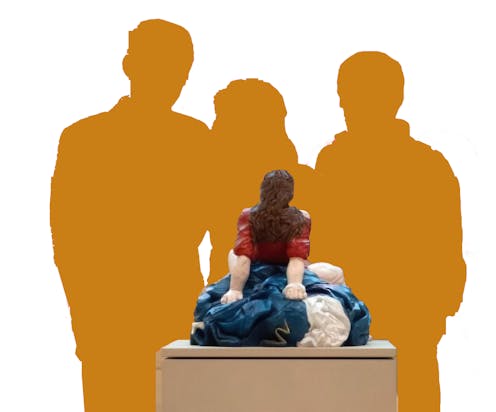A realistic statue of Mary giving birth was criticized, then vandalized − but saints and artists have often reimagined Christ’s birth
- Written by Virginia Raguin, Distinguished Professor of Humanities Emerita, College of the Holy Cross

A sculpture of the Virgin Mary[1] showing her giving birth to Jesus was recently attacked and beheaded. Called “Crowning” by the artist Esther Strauss[2], the sculpture had been part of a temporary exhibition of art outside the Catholic St. Mary Cathedral in Linz, Austria.
The sculpture was controversial for its explicit depiction of birth; an online petition seeking its removal received more than 12,000 signatures[3]. Strauss’ work was part of a project that sought to look at gender equality and the role of women, designed to honor the 100th anniversary of the cathedral’s consecration to the Virgin Mary. The exhibition opened on June 27, 2024, and the statue was vandalized a few days later.
My research as a historian of art[4] has shown me that there has never been only one way of depicting the birth of Christ.
Depiction of birth in early texts
Early Christian writings reveal that the birth of Christ was of keen interest and reflected ideas of the day.
A widely read text from the mid-second century, called the The Protoevangelium of James[5], gives details about the life of the Virgin and infancy of Christ. As women of that time gave birth with the aid of midwives, the text explained that the Mother of God also was helped in her labor. Sections 19-20 of the text give details about Joseph contacting two midwives.
One woman is said to have doubted the virgin birth. After she inserted her finger into Mary’s vagina, her hands withered. An illustration in a French prayer book from Paris dating to about 1490-1500[6] shows the midwife with missing hands. The story explained that her hands grew back after she touched the child Christ.
The representation of midwives, as seen in an 11th-century manuscript from Constantinople, is still common in the Eastern church[8].
Ideas change over time and place
New modes of spirituality in later centuries brought changes in art. St. Bridget of Sweden, who founded a new order of nuns, left a large body[9] or writing, including what she believed were revelations from God. One of her revelations included a vision of Christ’s birth[10] she experienced in Bethlehem in 1371–72.
Although Bridget had given birth eight times, she described Mary’s delivery as “in the twinkling of any eye.” Bridget said she “was unable to notice or discern how or in what member (Mary) was giving birth.” By “member” she may have meant that she did not know through what part of Mary’s body Jesus emerged. Many paintings between the 15th and 16th centuries adopted her vision and showed the child surrounded by light and the Virgin calmly worshipping him.
A painting by Belgian artist Hugo van der Goes, in about 1475, follows Bridget’s vision of the birth. Instead of being “wrapped in swaddling clothes[12],” Christ lies naked, perfectly clean, in the “great and ineffable light” that Bridget described.
Each era and community produces art that speaks to its own priorities. Fifteenth-century Italy introduced traditions of a miraculous childbirth[13] that were different from a realistic tradition cherished by early Christians of the second century. I would argue that “Crowning” is but one more example of such cultural change. Here, Mary is an inspiration for other women, physically strong and capable even in the difficult process of giving birth.
The sculpture, when intact, was barely 15 inches tall, a clear indication that it was not made for large-scale public veneration. It was a meditative image designed for a one-on-one encounter – for those who decided to engage.
References
- ^ A sculpture of the Virgin Mary (www.washingtonpost.com)
- ^ Esther Strauss (www.estherstrauss.info)
- ^ its removal received more than 12,000 signatures (www.washingtonpost.com)
- ^ as a historian of art (www.holycross.edu)
- ^ The Protoevangelium of James (www.newadvent.org)
- ^ about 1490-1500 (ica.themorgan.org)
- ^ Via Wikimedia Commons (commons.wikimedia.org)
- ^ is still common in the Eastern church (ucatholic.com)
- ^ left a large body (philamuseum.org)
- ^ included a vision of Christ’s birth (newtheologicalmovement.blogspot.com)
- ^ Florence Galleria degli Uffizi, Florence (www.wga.hu)
- ^ wrapped in swaddling clothes (www.biblegateway.com)
- ^ introduced traditions of a miraculous childbirth (www.italymagazine.com)
Authors: Virginia Raguin, Distinguished Professor of Humanities Emerita, College of the Holy Cross

